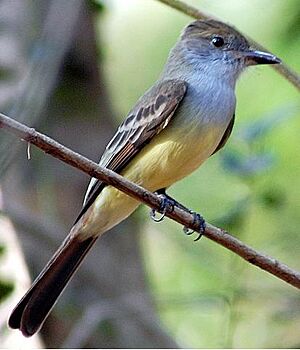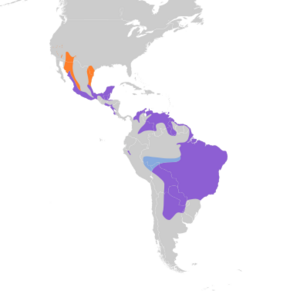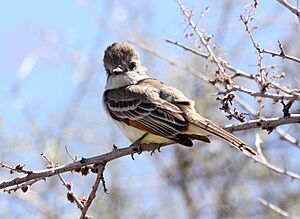Brown-crested flycatcher facts for kids
Quick facts for kids Brown-crested flycatcher |
|
|---|---|
 |
|
| At Piraju, São Paulo State, Brazil | |
| Conservation status | |
| Scientific classification | |
| Genus: |
Myiarchus
|
| Species: |
tyrannulus
|
 |
|
The brown-crested flycatcher (Myiarchus tyrannulus) is a type of passerine bird. It belongs to the tyrant flycatcher family. These birds are known for catching insects while flying.
About the Brown-crested Flycatcher
Adult brown-crested flycatchers are usually the largest birds in their group. Their size can change depending on where they live. They are typically about 20.3 cm (8.0 in) (8 inches) long. They usually weigh between 30 and 45 g (1.1 and 1.6 oz) (1 to 1.5 ounces).
These flycatchers have strong, thick bills. Their upper feathers are olive brown. They have a darker head and a short crest of feathers. Their chest is grey, and their belly is a bright lemon yellow. The brown feathers on their tail have reddish parts inside. Their wing feathers also have reddish outer parts. You can also see two faint bars on their wings. Male and female birds look very similar.
The best way to tell a brown-crested flycatcher apart from other similar birds is by its call. It makes a loud, rough sound. It sounds like "come HERE, come HERE" or "whit-will-do, whit-will-do".

Where They Live and What They Eat
The brown-crested flycatcher builds its nests in open woodlands. You can find them in places like southern California, Arizona, and Texas. They also live in most of Brazil, and in countries like Argentina and Bolivia. You can also find them on the islands of Trinidad and Tobago.
Most of these birds stay in the same place all year. However, those that nest in the United States fly south for the winter. They spend the colder months in Mexico or southern Florida.
This bird is an insectivore, meaning it eats insects. It often hides among plants and catches its prey while flying. Sometimes, it also eats fruit, like the "gumbo-limbo" fruit. The brown-crested flycatcher builds its nest inside a tree hole or another natural opening. It can also use man-made holes. A female usually lays two or three cream-colored eggs. These eggs often have purple marks on them.


